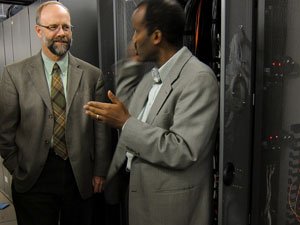Blade runner

Minnesota Supercomputing Institute begins second quarter century with increased capacity
By Rick Moore
In the basement of Walter Library, the machines of the University of Minnesota Supercomputing Institute for Advanced Computational Research (MSI) are doing work that would make most people's heads spin. Work to the tune of trillions of calculations per second, and work that benefits more than 4,000 active users.
Now in its 25th year, MSI is the proud owner of an important research tool: a new supercomputer, named "Itasca" by MSI and powered by 1,083 HP ProLiant BL280 G6 blade servers. The new system is ranked No. 67 on the Top 500 list of the world's most powerful supercomputers.
"Today, high-demand computation is absolutely central to a wide array of important research areas that are vital to putting the University of Minnesota in a leadership position," says Tom Jones, interim director of MSI. "This new computing system is a big step above systems at most other universities, so our faculty and students are really excited by the big boost in computational power they will have to drive the frontiers of knowledge."
And what a boost it is. Prior to installing the new system, MSI had a cumulative theoretical computing performance of 32 teraFLOPS, meaning 32 trillion mathematical computations per second, according to Brian Ropers-Huilman, the director of systems administration and technical operations at the institute. The new HP blade servers deliver 97 teraFLOPS of performance -three times MSI's previous capacity. Factoring in MSI's remaining supercomputing systems, the new capacity is 127 teraFLOPS, which will expand research capabilities immensely.
"[The increased capacity will] improve the quality of the science, in some cases allowing [researchers] to solve larger problems and produce more precise results," Ropers-Huilman says. In addition, the increased capacity will enable researchers to process more data to solve their problems, producing faster results, he says.
A quarter century of enhancing research
Way back in 1981 - before anyone dreamed of a laptop computer that you could throw in a tote bag and bring to a coffee shop - the University of Minnesota became the first university to purchase a class VI supercomputer, a 100 megaFLOP Cray 1. Soon thereafter the U began recruiting faculty in research areas that used supercomputing, and it created the Minnesota Supercomputing Institute in 1984.
Over the years, the core mission of MSI has stayed constant: to provide supercomputing resources to academic researchers and to facilitate cutting-edge computational research. And while the supercomputers themselves have changed dramatically in 25 years, so have the needs of their users.
For years, researchers in the physical sciences and engineering were the core users of MSI's resources. Now biologists and medical researchers are increasingly in need of high-end computing and the software packages that MSI offers for genomics, proteomics, and related fields. In fact, the Academic Health Center now has the highest number of MSI principal researchers among U colleges.
This expansion across a wider range of disciplines is paying dividends for the University. In 1989-90, the first year MSI tracked external funding, MSI researchers received about $11.5 million. For the 2008-09 academic year, researchers brought in $103.9 million in external funding.
Researchers at the U use supercomputers for a range of activities, often crossing academic disciplines, which has implications for Minnesota and around the world. Some examples:
- The new I-35W bridge contains sensors that analyze structural behavior. Researchers at the U - including Catherine French, Carol Shield, and Henryk Stolarski - are using MSI resources to evaluate data they collect. Monitoring the new I-35W bridge could lead to a better understanding of similar bridges, ultimately contributing to increased bridge safety.
- The Center for Research in Education and Simulation Technologies (CREST) is improving surgical education with the use of virtual reality-based trainers. In collaboration with MSI, CREST researchers are developing interactive, real-time simulation and visualization for remote surgical training, and MSI is providing hardware, software, and technical user support.
- Gunda Georg, an internationally known medicinal chemist, directs the Institute for Therapeutics Discovery and Development, where researchers conduct interdisciplinary research in drug discovery and development. They use MSI's resources to safely and securely record and manage the enormous amount of biological data generated during the drug discovery process.
- A group of researchers led by Fumiaki Katagiri is using MSI resources to investigate how plants recognize the molecular signals of pathogen attack and how they then coordinate their defense responses. The work may lead to methods of disease control that are safer than current methods for humans and for the environment.
In addition, MSI is a great resource for University students, both graduate and undergraduate. A large number of grad students work in MSI research groups. And the Undergraduate Internship Program introduces students to the kind of research they would do as graduate students at the U.
As Vice President for Research Tim Mulcahy points out, we're living in an "information-intense world," and high-end computing capacity is increasingly in demand. To that end, the addition of the new supercomputer is a boon to the University.
"One of the real assets of MSI is the staff expertise and consultation that is provided for faculty around the hardware," he says. And "the addition of Itasca really puts us in a competitive position in terms of the hardware."
